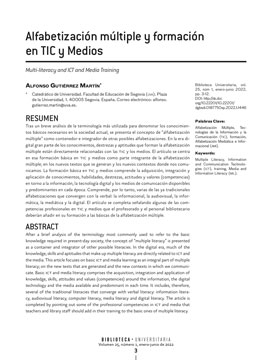Multi-literacy and ICT and Media Training
DOI:
https://doi.org/10.22201/dgbsdi.0187750xp.2022.1.1446Keywords:
Multiple Literacy, Information and Communication Technologies (ict), training, Media and Information Literacy (mil)Abstract
After a brief analysis of the terminology most commonly used to refer to the basic knowledge required in present-day society, the concept of “multiple literacy” is presented as a container and integrator of other possible literacies. In the digital era, much of the knowledge, skills and aptitudes that make up multiple literacy are directly related to ICT and the media. This article focuses on basic ICT and media learning as an integral part of multiple literacy; on the new texts that are generated and the new contexts in which we communicate. Basic ICT and media literacy comprises the acquisition, integration and application of knowledge, skills, attitudes and values (competencies) around the information, the digital technology and the media available and predominant in each time. It includes, therefore, several of the traditional literacies that converge with verbal literacy: information literacy, audiovisual literacy, computer literacy, media literacy and digital literacy. The article is completed by pointing out some of the professional competencies in ICT and media that teachers and library staff should add in their training to the basic ones of multiple literacy.
Downloads
References
Carr, N. (2008). Is Google Making Us Stupid: What the Internet is doing to our brains. The Atlantic, julio-agosto. https://cutt.ly/PJihTYk
Carr, N. (2020). The Shallows: What the Internet Is Doing to Our Brains. W. W. Norton & Company.
Carretero, S., Vuorikari, R. y Punie, Y. (2017). DigComp 2.1: The Digital Competence Framework for Citizens with eight proficiency levels and examples of use. Publications Office of the European Union. 10.2760/38842
European Council of Information Associations. (2004). Euroreferencial en Información y Documentación: Vo- lumen 1 Competencias y aptitudes de los profesionales europeos de información y documentación. cedic. https://www.sedic.es/wp-content/ uploads/2019/06/euref1-espanol.pdf

Downloads
Published
How to Cite
Issue
Section
License
Descargar el formato de Cesión de derechos en formato PDF:
Formato de Cesión de derechos
Imprímalo y una vez que lo haya firmado envíenoslo vía fax o por correo a:
Revista Biblioteca Universitaria:
Dirección General de Bibliotecas y Servicios Digitales de Información de la UNAM
Departamento de Publicaciones
Edificio de la Biblioteca Central, 11o Piso,
Circuito Interior, Ciudad Universitaria, 04510 México, D.F.
Tel 5622-1616,
Fax: 5622-1601,






